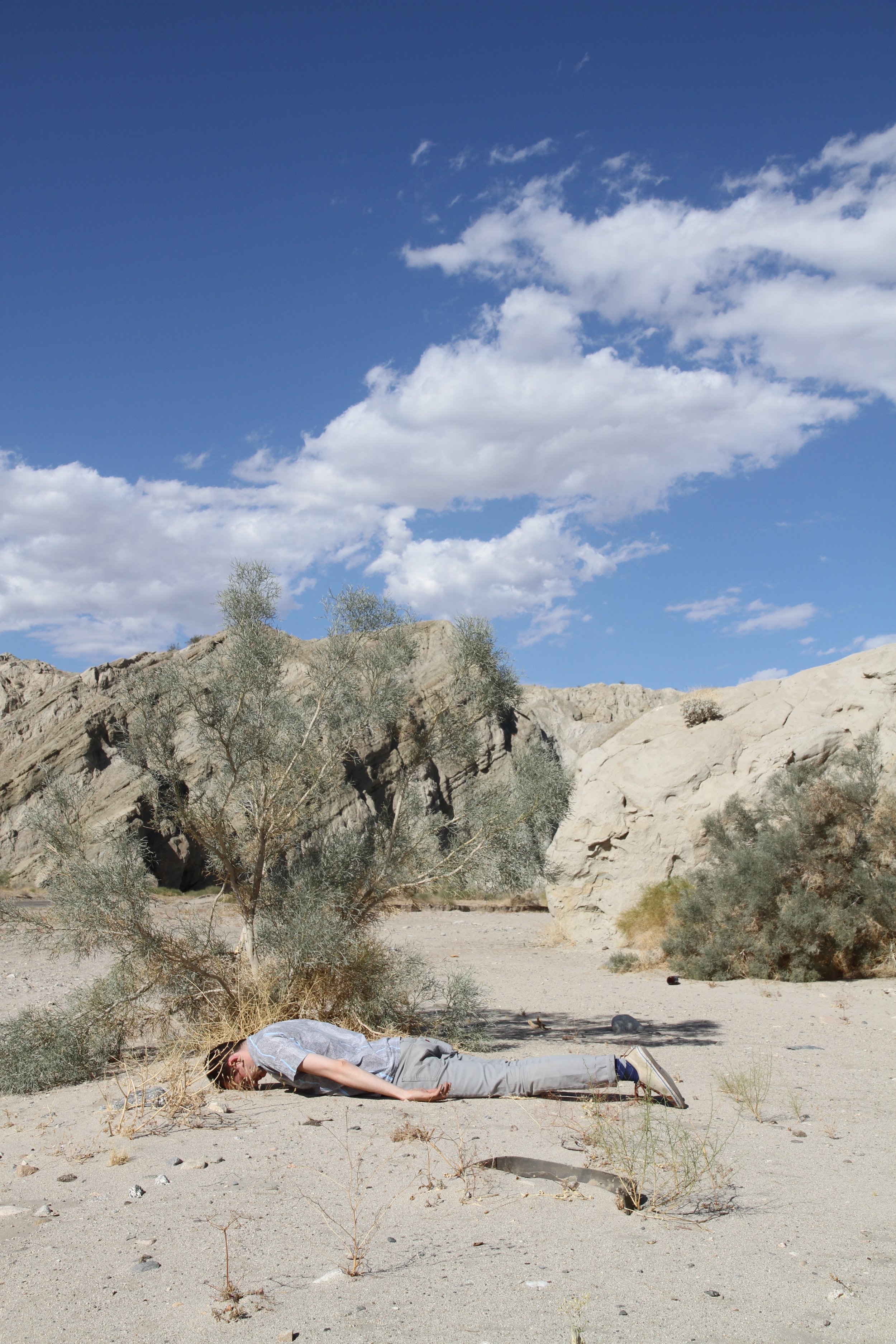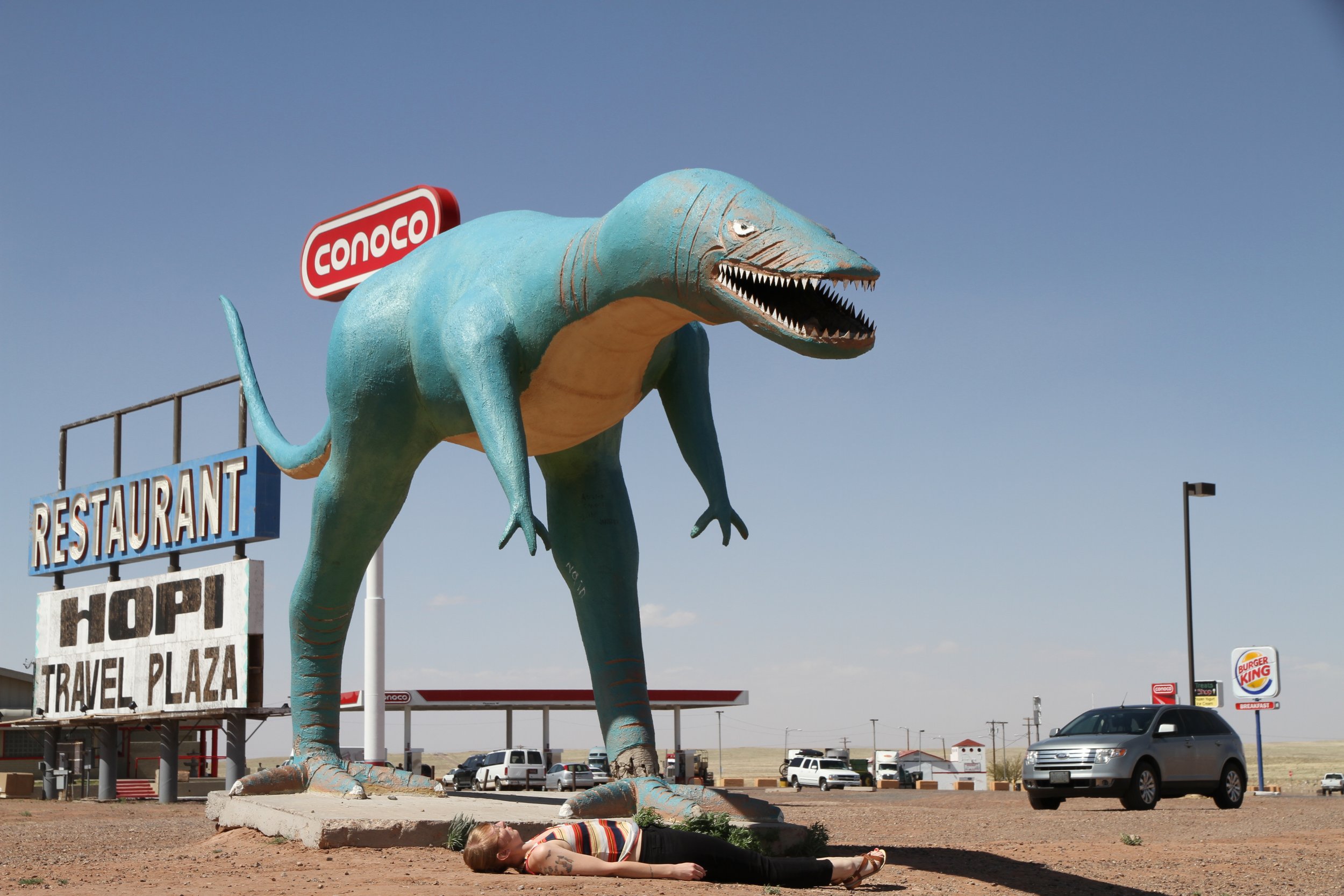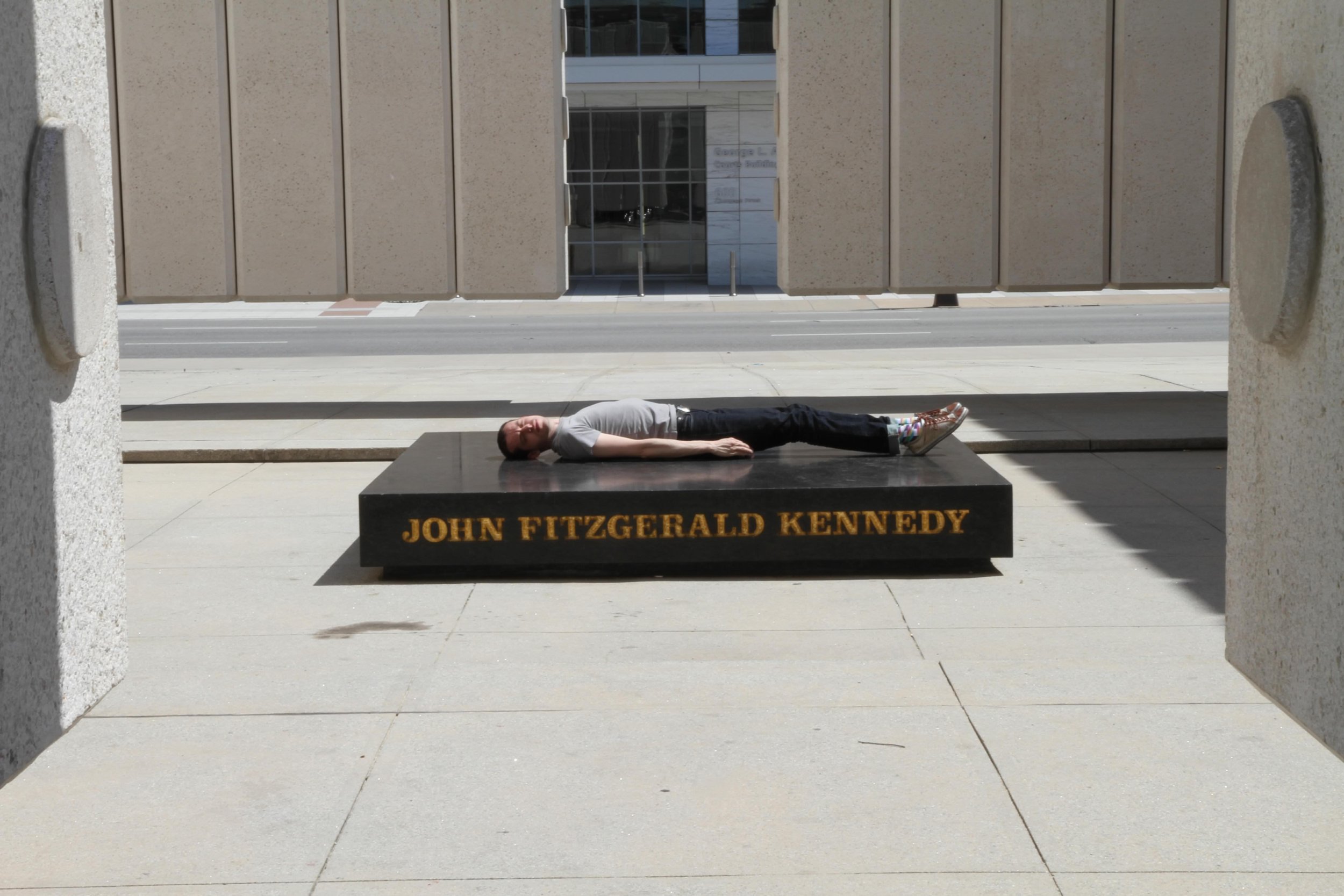
Without Me, You’re Nothing
By Logan MacDonald
Originally published by UN Magazine
AA Bronson, Felix Pratz, June 5, 1994 (1996), lacquer on vinyl, 84 x 168”. Courtesy of the artist.
Spring several years ago, fellow Canadian artist Lisa Visser and I embarked on a two-week road trip, driving 5,300 kms from Toronto across the United States to Los Angeles, during which time a collaborative project emerged. The purpose of this road trip was to move Lisa to California, so that she could carry out graduate research. I was essentially freeloading, desperate for a holiday, and following along after Lisa had offered me a ride to keep her company.
Early into our trip we decided that as two artists with similar creative interests in relational aesthetics and social practice based art, we would embark on some sort of collaboration. At first we had no clear idea how to even start. Then, through play, our shared work came together. It started with me behaving like a brat — trying to steal Lisa’s attention from the hotel television. Like a cat I intentionally laid my body corpse-like in front of the giant television to block her view, much to Lisa’s delight. She playfully snapped a photograph of my languid pose and this became the catalyst for our project. We went on to challenge each other by scouting locations and photographing each other, lying down, in various locations across America, alternating roles as performer and photographer. In agreement, we titled the series of images Getting Laid in America (2011).
The premise of this project was a loose intersection for both our creative interests. Like Lisa, I was a graduate student. My interests were in creating performance art that addressed queerness in public spaces, specifically documenting the insertion of queer bodies and queer representation into what I thought to be heteronormative spaces — even though my work struggled to illustrate this interest. More importantly, I had newly discovered the gay-cruising app Grindr, an app that exposed me to a new world of gay engagement as I wasn’t much for cruising at gay bars. Lisa was equally excited and encouraging, vicariously living through my new-found sexual outlet and gaining access to these random experiences. Lisa wanted frequent updates and was happy to discuss any progress I had made throughout the trip. I think, like me, Lisa found the whole thing rather liberating.
Lisa’s art practice at the time (her graduate work) was centered on looking at interspecies relationships, especially thinking through human-animal kinship. She had developed a body of work that focused solely on the relationship between herself and Sushi, her cat. Animals in the Room (2010–11) is a series of photographs that documented her engagement with Sushi in an empty room, essentially framing herself and her cat as the sole subjects — existing next to each other, in what could be thought of as staring contests. Lisa’s underlying goal was to contemplate how their coexistence was imbalanced through dependence.1 One of my favorite sentiments — that comes from Lisa — and the origin of this essay’s title is WITHOUT ME, YOU’RE NOTHING, the title she gave to another of her ‘collaborative’ performances focusing on Sushi. The piece is a series of photographs framing Lisa engaging with Sushi, this time with Lisa offering Sushi a handmade quilt patched together to read the title of the work. In Lisa’s statement about this work she outlines how her existence is relative to Sushi’s, but how this is not a reciprocated role. Lisa makes clear that her life would not be impacted by the omission of Sushi, but Sushi’s life is entirely dependent on her existence. As much as I’d like to agree with Lisa here, this was an eerie foreshadowing that did not hold true.
And so, the title of our project Getting Laid in America alludes to the obvious horizontal position we took in each photograph, as much as it also winked to our conversations throughout the trip: as two friends talking about art, existence, what it means to be human, connection, play, subjectivity, and feeling our way through discussions of sexual exploration. The project resulted in fourteen photographs taken over this two-week travel period.
Getting Laid in America has never been exhibited.














Logan MacDonald and Lisa Visser, Getting Laid in America (2011), photography.
At the peak of our excitement over the project, shortly after we had finished the work, we were made aware of a new fad that was sweeping the globe (particularly in America and Australia) called planking. Both The Guardian and the once popular but now defunct online news hub Gawker Media had posted stories that outlined the craze, in which young people were documenting themselves rigidly laying down in absurd places and posting pictures of these interventions on social media.2 Largely understood as a public prank, the activity was criticised for being dangerous. The stunts were popular enough to have been cited in a rap song and have their own Wikipedia page.3 Lisa and I were completely oblivious, and while we were both intrigued that we’d inadvertently tapped into the collective consciousness, we were also crestfallen. Through email exchanges we tried to figure out where and how this work should exist beyond our trip, but it never came of much beyond fodder for our respective websites.
Shortly after this trip, Lisa was diagnosed with terminal cancer and died within two years. Mourning Lisa’s death is an ongoing process; I often reflect fondly upon our friendship. Within that reflection I’ve thought about different ways in which I can keep her memory honoured and alive, and one of these ways has been in thinking about what to do with our collaborative work. But I find myself asking, how do I move forward with the work we both invested energy and aspirations into? What am I to do with Getting Laid in America? As someone who is profoundly affected and invested in the ethics of relationships, it feels uncertain whether I even have the right to finish this work and put it into the world without Lisa by my side. This writing is my attempt to work through these questions, to bear witness to this collaboration that has been on pause since 2011, and tease out the ethics at stake. I want to think through what a collaborative project with someone who is deceased means. It’s me asking a simple question: how does one move forward? To help guide me through this process, I located a few other artists who have contributed to the conversation around navigating collaboration with the inaccessible.
Canadian artist AA Bronson is the sole survivor of the General Idea art collective. His collaborators, Jorge Zontel and Felix Pratz, met AIDS-related deaths in 1994 and since then Bronson has been the steward over the General Idea collection. One of the last works that possibly falls under the General Idea collaboration is the final portrait photograph of Pratz on his deathbed, mere moments after his demise. While the work Felix Pratz, June 5, 1994 (1994) is artistically credited to Bronson, this work forces us as the audience to reckon with the trust of their collaborative practice and intimate relation. It is possible that this work also serves a second purpose for Bronson; I think that, by citing himself as the sole creator of the work, he is clearly and thematically marking the end of General Idea. It seems fair to assume that any decision Bronson now makes regarding the work of General Idea lives outside the initial collaboration. But still, how to understand these decisions in relation to the corpus of General Idea? How do we mark the difference between a decision made during collaboration and the impacts of that decision after a member’s death? What are the ethics of a last living member presenting collective collaborative works? And more so, how do we consult and decide with the dead? This is something I feel I need to negotiate in my collaborative work with Lisa.
Looking at the final image of Felix, we understand that this photograph was taken moments after death. As such, he becomes inaccessible. He is incapable of offering a voice, and no longer able to advocate or consent to this collaboration. But I think we trust Bronson. We trust based on their past association. We accept that an agreement was reached, one that was accompanied by like-mindedness, negotiation and consent. And with that, we can accept Bronson’s agency in steering how that collaboration came to be, to how it will continue to exist: between photographer and subject; between artists; and with the public. Should we categorise the work as memorialisation, portraiture, collaboration — or perhaps a meld of the three?
Canadian artist Jordan Bennett’s recent work in Wije’wi (Come With Me) (2017) brings Mi’kmaq and Beothuk historic visual culture from Ktaqamkuk into contemporary design.4 His recent work draws from historical materials and imagery that was cultivated by people decades ago — imagery that he folds into modern design motifs. I wonder, when we draw upon the dead in a memorialisation, when we engage with past aesthetics, past words, past ideas — are we not collaborating with them? I don’t mean to dismiss a lineage of continuous cultural production, or ignore that community elders are alive and accessible bearers. Instead I’d like to further consider that Bennett is directly collaborating with ancestors or members of his heritage from generations past. By drawing on their aesthetics, such as the drawings of Shanawdithit, Bennett is engaging with those who are inaccessible. I would argue that Bennett’s work, along with many other present-day artists with Indigenous backgrounds who engage with ancestral aesthetics, is a form of collaboration. As an artist also with Mi’kmaq ancestry I relate to Bennett, and like many contemporary artists who identify as having Indigenous ancestry, I find urgency in the need to combat omnipresent colonialism — without connecting this backwards-referencing artistic gaze to current practice, I feel we risk colonial erasure. The reason for reflecting on indigenous ancestral collaboration here, while different in many ways from my relationship with Lisa, is that there are echoes in the possible desires to continue aesthetic work and honour cultural memories of the dead. Moreover, I feel this example also importantly helps restructure how we might understand individual consent of collaboration as different from cultural responsibility and reciprocity.
I think it’s important to link consent to collaboration, especially with the recent activism and advocacy such as the #metoo movement that has amplified the necessity of consent for any form of ethical engagement, both at the public and interpersonal level. It only seems logical that consent need play a necessary role in collaboration — but how artists navigate questions of consent with the inaccessible, specifically the dead, is never straightforward. Ultimately, there’s no resolve for the loss of a voice from within a collaboration. I do wonder what Lisa would have wanted, what she would have advocated strongly for and against in the creative and strategic advancement of our work together? And how this would have affected our work together?
Jordan Bennett, 'Nisqunamu’k Kmtn (Purple Mountain) (2016), acrylic on carved wood panel, 36 x 36”. Courtesy of the artist.
In Lisa’s graduate thesis written in 2011, in her own words she outlined a particular form of connecting between species, offering an idea pioneered by theorist Donna Haraway called ‘becoming with’5 Lisa uses one example in her thesis, which I hesitate to draw upon, but I cannot afford to ignore this opportunity to uses Lisa’s own logic in speaking about an artistic exchange between living and dead entities. In her text, she examines Australian artist Shaun Gladwell’s video piece Apologies (2007–09). The video frames the experience of a motorcyclist encountering the corpse of kangaroo on the side of a highway, in which the individual intimately cradles the road-kill with compassion — Lisa describes the instance as a human searching to connect, to achieve ‘becoming with’, despite the animal being dead.6 She uses this as an example to dig deeper into questions of why we, the living, would engage at all, with animals or humans, living or dead. We do this, she explains, to ‘become with’. For me, I think that by drawing attention to ‘becoming with’ in this instance, she perfectly summarises collaboration in general, with anyone or anything living or dead. When we collaborate, are we not ultimately searching for moments of ‘becoming with’? I think one of the reasons I am continuously drawn back to Getting Laid in America, a project we may never have completed even if Lisa were still alive, is in the desire to become with Lisa, to find a way in which we can reunite, to transcend death. Is it not true of all collaboration that we return to these engagements because there’s something there for us?
Logan MacDonald is a visual artist, educator and curator of Scottish, Irish, English and Mi’kmaq ancestry operating out of Tkaronto, Turtle Island.
1. Lisa Visser’s website: http://lisavisser.ca/
2. Tom Meltzer, ‘Planking: a brief history’, The Guardian, 17 May 2011, https://www. theguardian.com/ world/2011/may/16/ planking-a-brief- history, accessed 10 September 2018; and Lauri Apple, ‘Planking is the New Internet ‘Craze’, as Long as You Don’t Die’, Gawker Media, 15 May 2011, http://gawker. com/5802048/ planking-the-new- internet-craze-as- long-as-you-dont- die, accessed 10 September 2018
3. Wikipedia: Planking (fad), https://en.wikipedia.org/wiki/Planking_(fad), accessed 10 September 2018.
4. Jordan Bennett’s website: www.jordanbennett.ca
5. Donna Jeanne Haraway, When Species Meet, Minneapolis: University of Minnesota Press, 2008.

